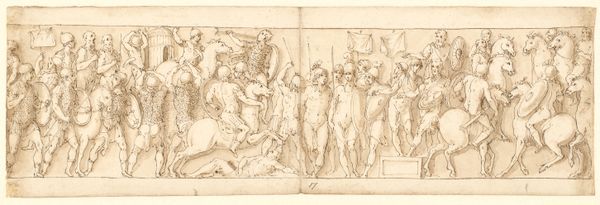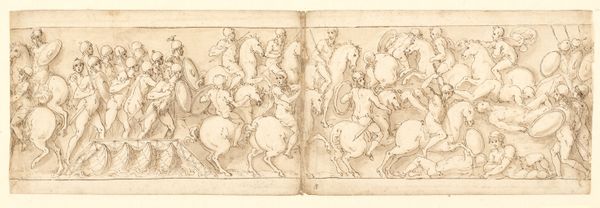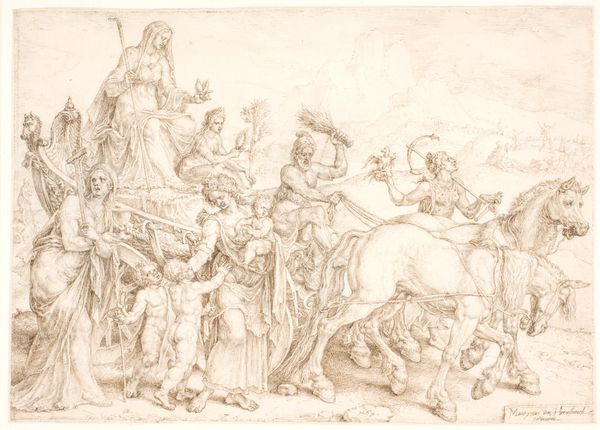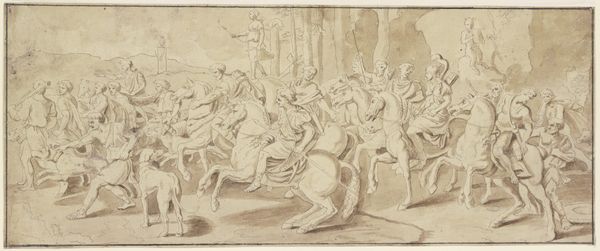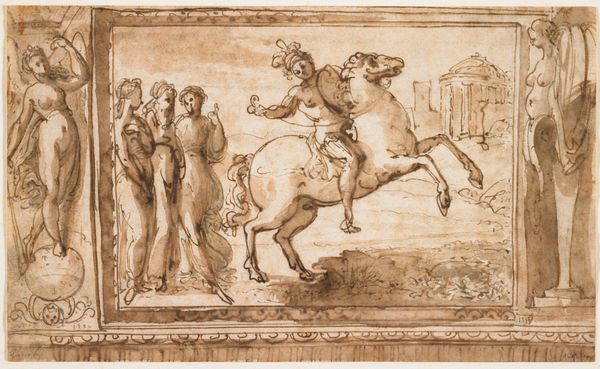
Captured women are taken away (end of LXXIII); parade of the lifeguards (LXXIV); Marcus Aurelius sacrifices at an altar (LXXV); Marcus Aurelius watches an attack (beginning of LXXVI) 1544 - 1618
0:00
0:00
drawing, ink, pen
#
drawing
#
narrative-art
#
etching
#
figuration
#
ink
#
ancient-mediterranean
#
pen
#
history-painting
Dimensions: 133 mm (height) x 432 mm (width) (bladmaal)
Curator: This pen and ink drawing is by Giovanni Guerra, dating from 1544 to 1618. The title is quite descriptive: "Captured women are taken away; parade of the lifeguards; Marcus Aurelius sacrifices at an altar; Marcus Aurelius watches an attack." Editor: It immediately strikes me as processional, almost frieze-like in its continuous narrative. The pale tonality gives it a classical feel, as if viewing an ancient relief. There’s something ceremonial happening here, but with underlying tension. Curator: Guerra seems to have aimed for something monumental despite working on paper. We see him grappling with power dynamics. The scenes depicting captured women and battle hint at imperial violence. Editor: Yes, that procession of figures certainly bears the weight of conquest. But look at the horses! They seem restless, adding a layer of psychological depth. Are they metaphors for untamed aspects of leadership, the impulses barely held in check by the reins? Curator: An intriguing observation. It connects to a broader examination of Marcus Aurelius, depicted both in civic and martial roles. It encourages discussion about leaders’ ethical obligations when exercising control in varied historical contexts. I think it opens conversations regarding gender dynamics of war and societal values ascribed to military success and power, both back then and even now. Editor: The repeated symbol of sacrifice… that's also pivotal. Does it show an attempt to justify these displays of power, to align them with the divine? Curator: Perhaps it reflects the need for rulers to legitimise their authority through tradition, particularly with its cultural context. Are we, as modern viewers, able to reconcile this with scenes of military conflict and its victims? It definitely encourages us to think of moral accountability. Editor: Absolutely, the artist contrasts contrasting concepts that allows to reflect on this need. It feels so current even across all the history, don't you think? Thinking about the iconographic continuity in the image helps consider all these cultural values that prevail throughout centuries... Fascinating! Curator: Yes, I think reflecting about the impact that war and societal roles play, still impacting nowadays gives so much value to his artwork!
Comments
No comments
Be the first to comment and join the conversation on the ultimate creative platform.


